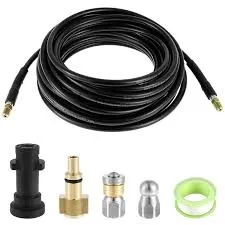Understanding Power Steering Hose Lines and Their Importance in Automotive Systems
Understanding Power Steering Hose Lines A Comprehensive Overview
Power steering systems have become a standard feature in modern vehicles, significantly enhancing the driving experience by making steering smoother and more effortless. A critical component of these systems is the power steering hose line, which plays an essential role in transferring hydraulic fluid from the power steering pump to the steering gear or rack. Understanding the significance, function, and maintenance of power steering hose lines can help vehicle owners ensure optimal performance and prolong the lifespan of their steering systems.
What is a Power Steering Hose Line?
The power steering hose line is typically made from reinforced rubber or a combination of rubber and metal that allows it to withstand high pressure. This component is responsible for transporting hydraulic fluid, which is necessary for the power steering system to function effectively. The hydraulic fluid helps amplify the force exerted on the steering wheel, making it easier for drivers to maneuver their vehicles, especially at low speeds or during parking.
There are usually two types of hoses in a power steering system the high-pressure hose, which carries fluid from the pump to the steering gear, and the return hose, which returns the fluid back to the reservoir. The high-pressure hose is designed to handle the intense pressure generated by the pump, while the return hose operates under much lower pressure.
Signs of Issues with Power Steering Hose Lines
As with any vehicle component, power steering hose lines are susceptible to wear and tear over time. Several warning signs can indicate issues with these hoses
1. Fluid Leaks If you notice fluid pooling under your vehicle or see streaks on the hoses, it may indicate a crack or rupture in the hose line. Power steering fluid is generally reddish in color, making it easier to identify.
power steering hose line

3. Whining Noise If you hear a whining or groaning noise when turning the wheel, it may indicate that the power steering pump is struggling to move fluid due to a blockage or leak in the hoses.
Maintenance and Replacement
Regular maintenance of the power steering system is crucial to prevent costly repairs down the line. Here are some maintenance tips
- Check Fluid Levels Regularly check the power steering fluid level and top it off as necessary. Low fluid can cause excessive wear on the pump and hoses.
- Inspect Hoses Periodically inspect the power steering hoses for signs of wear, such as cracks, bulges, or severe discoloration.
- Flush and Replace Fluid Over time, the hydraulic fluid can become contaminated or lose its effectiveness. Flushing the system and replacing the fluid can help maintain optimal performance.
If there's a noticeable problem with the hoses, replacing them promptly is essential to avoid further damage to the power steering system. This task generally involves removing the old hoses and installing new ones, which can usually be done by a professional mechanic.
Conclusion
Power steering hose lines are invaluable to the functionality of a vehicle's steering system. By understanding the vital role these hoses play and recognizing the signs of potential issues, drivers can take proactive measures to maintain their vehicle’s performance. Regular inspections and timely replacements can make a significant difference, ensuring a smooth and responsive driving experience. Whether you are a car enthusiast or an everyday driver, staying informed about the components that keep your vehicle safe and manageable is always beneficial.
-
Ultimate Spiral Protection for Hoses & CablesNewsJun.26,2025
-
The Ultimate Quick-Connect Solutions for Every NeedNewsJun.26,2025
-
SAE J1401 Brake Hose: Reliable Choice for Safe BrakingNewsJun.26,2025
-
Reliable J2064 A/C Hoses for Real-World Cooling NeedsNewsJun.26,2025
-
Heavy-Duty Sewer Jetting Hoses Built to LastNewsJun.26,2025
-
Fix Power Steering Tube Leaks Fast – Durable & Affordable SolutionNewsJun.26,2025

